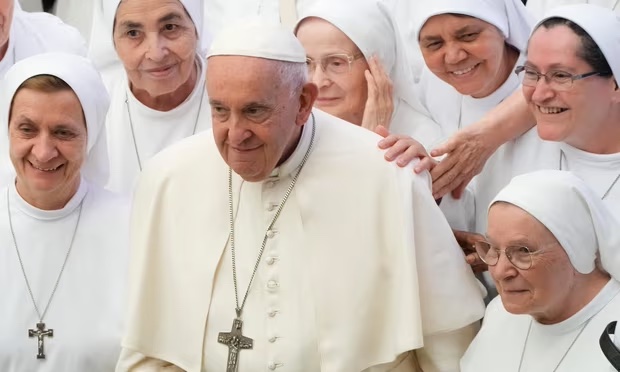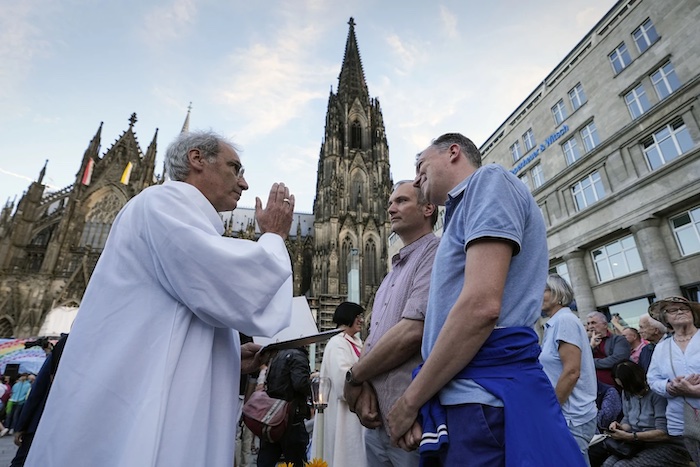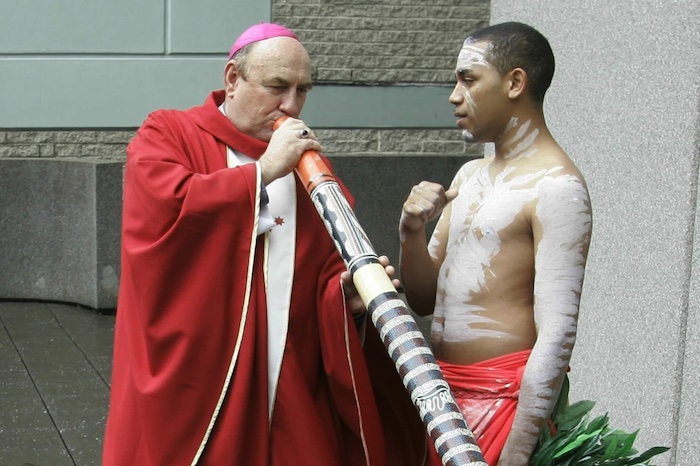— Event organisers say it’s ‘crunch time’ for pope as scandal and bigotry drive Church members to leave

They make up more than half its membership, they have been denied a say for centuries in the way it is run: but, early next month, women will gather in Rome for a process that they hope can bring the Catholic church’s thinking on female equality into the 21st century.
The central event is a mass listening exercise announced by Pope Francis in 2021, the synod on synodality. Its delegates will meet in Rome throughout October to discern the future direction of key issues in the church; and at the forefront of soundings already taken across the 1.3 billion-strong Catholic church across the globe has been the role of women.
To underline this clamour for change, a consortium of 45 pro-reform Catholic organisations will run their own synod – entitled Spirit Unbounded – alongside the official event: and former Irish president Mary McAleese, who will be among its keynote speakers, says it is crunch time for Francis and his cardinals and bishops. “They have to do something more than a cynical exercise in kicking the can down the road,” she says. “If the cardinals and bishops can be humbled into listening to the people of God, maybe the Holy Spirit will have a chance to bring about change.”
If not, she says, it is hard to see a way forward in a church that has shedded members – certainly in Europe and the west – and been ravaged by abuse scandals, financial misconduct and a dearth of men signing up to become priests.
“The scandals show up the craven stupidity of so many of the members of the magisterium,” says McAleese, who was president of Ireland – a country that bore the brunt of Catholic abuse scandals – from 1997 to 2011. “And, of course, there have always been examples of appalling teaching: but we are in a different generation now, with a highly educated laity who are more than capable of critiquing church teaching,”

Women in particular, she says, are being “driven away”: “They’re seen as second class and they won’t put up with it any more.”
Also addressing the alternative synod will be Cherie Blair, who will tell participants that “the church’s track record on women is at best mixed”, but that it needs to change and should not be afraid to change. “There remains a strong sense that the church does not do enough for women, that its structures and teaching on matters such as birth control and its priorities do not always serve women well,” she says in a pre-recorded video message.
For many, top of the change agenda is female ordination: admitting women first as deacons, and in time as priests. Miriam Duignan of Women’s Ordination Worldwide, one of the organisations taking part in Spirit Unbounded, is expecting hundreds of pro-ordination supporters for a march in central Rome on 6 October, as the synod on synodality gets under way.
Her organisation is also planning some “surprise” events, she says. “In almost every parish in the world where synod discussions took place, from Lesotho to the Philippines to Peru, women were talked about as an area where change is needed,” she says. “The Catholic church doesn’t have enough priests, and yet everyone knows nuns and laywomen who are already doing 90% of the work in the parishes – then they have to stand aside when a priest is needed to say mass.”
She adds. “Right now we’re at a tipping point: it’s clear that women are doing the work of priesthood, and they want to be recognised as priests.”
Despite what’s seemed a hard line against women priests from the Vatican, Duignan says there’s “below the radar” support from many priests and bishops. On demonstrations, she says: “We’ve had priests smiling at us, putting their thumbs up, clapping. One cardinal said ‘brava’ to me.”
Since becoming pope in 2013, Francis has convened two commissions to look into the question of female deacons. It is widely acknowledged that women served in leadership roles in the early years of the church and, says Duignan, as late as the 15th century women abbesses were hearing confessions and presiding at eucharistic services. But so far, Francis has failed to act. “He has a blind spot where he doesn’t see that the discrimination he speaks out against in wider society also happens in the Catholic Church.”
The official Synod Instrumentum Laboris, or working document, asks synod delegates to consider how women can be better included in the governance, decision-making, mission and ministries at all levels of the church, and asks whether women deacons could be envisaged. Although it doesn’t mention the possibility of female priests, many believe this would follow a decision to admit women to the diaconate, as happened in the Church of England – women were first ordained as deacons in 1987, and as priests in 1994.
Penelope Middleboe of the UK Catholic reform group Root and Branch, one of the lead organisations behind Spirit Unbounded, says the alternative event reflects suspicions about whether the official synod is properly taking laypeople’s views into account.
“In England and Wales, we researched what happened to points raised in the parish discussions, where there were calls for more action on abuse, for the inclusion of LGBTQ+ people, and for women to be admitted to the priesthood and to leadership roles – but we found these had been watered down by the bishops who filtered them for the report document,” she says.
And while the official synod is the first ever event of its kind in the Catholic church to include voting women, there are far more bishops with a vote than women. “Also, the few women involved have been chosen by the bishops – many of them work for Catholic institutions, so they’re not always able to speak their minds.”
Freedom to speak, and an ability to listen, are essential ingredients in what happens next, says McAleese: “I believe change is possible, which is why I stay – because many argue that by staying you’re collaborating or colluding with inequality. I feel that myself: but I feel I must stay to nudge the internal debate, and to press for change.”
Complete Article ↪HERE↩!




